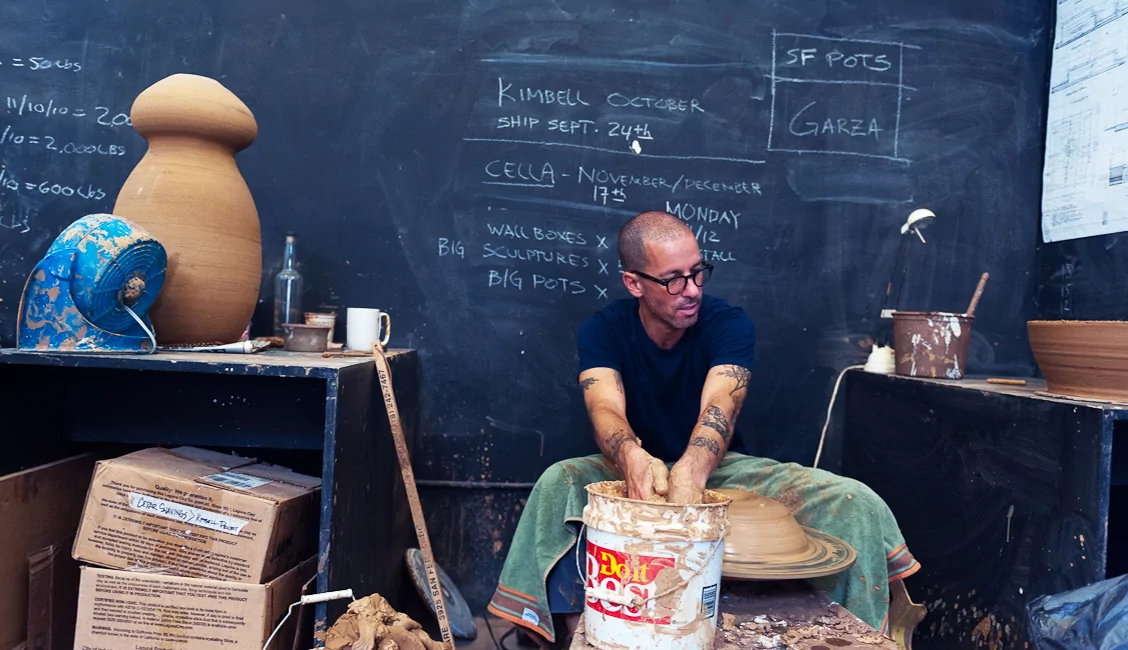
ABOUT ADAM SILVERMAN
Adam Silverman was born in New York, raised in Connecticut and educated at The Rhode Island School of Design, from which he holds a Bachelor of Fine Arts and a Bachelor of Architecture. He moved to Los Angeles in 1988 and practiced architecture before moving in to the fashion industry for almost nine years. He continued to make pots as a hobby on the side, which he started practicing when he was back in High School. He’s been a full time professional potter since Fall of 2002.
Interview date: 16th of August, 2013
Photography by Katrina Dickson
INTRODUCTION
Surprisingly, our interview section hasn’t been decorated with many potters. So it’s refreshing to add such a highly acclaimed potter to the list, whose work is both sculptural, experimental and creative.
Adam Silverman is not only an interesting subject because of his works, he’s also lived quite a varied life and has travelled across many parts of Japan, working and learning from a mixture of master craftsmen. This is no doubt reflected in his forms, the vessels have a real purity and minimalistic vibe about them, much like what you’d see in Japan, but they’re layered with intricate colouring and other unusual glazes, which could reflect from him being born in NY and living most of his life in LA.
After co-founding popular clothing labels X-Large and X-Girl, Adam found himself spending more and more time in the studio making pots, so in 2002 he decided to jump right in and become a full time potter. Since then Adam has exhibited extensively in the US and Japan. Besides making his own works, Silverman has also become a partner in, and the studio director of, Heath Ceramics, a 62 year old California producer of dinnerware and tile. I hope you enjoy our conversation below.
1. FOR THOSE THAT DON’T KNOW ADAM SILVERMAN, COULD YOU TELL US A LITTLE BIT ABOUT YOURSELF AND WHAT YOU DO?
I am a potter in Los Angeles. Prior to becoming a professional potter in 2002 (after a lifetime of being a hobby potter) I was an architect and then in the fashion business … all in LA. I have lived in LA for almost 25 years. I am married to Louise Bonnet, who is a painter, and have four children ranging in age from 3 to 14.
2. WHAT WOULD YOU SAY IS YOUR WORKING PHILOSOPHY?
Work hard and work smart so that I don’t have to work all the time.
3. WE KNOW YOU FOUNDED A WELL-RECOGNISED CLOTHING COMPANY NAMED X-LARGE IN YOUR YOUNGER DAYS. COMING FROM THIS BACKGROUND HOW DID YOU ORIGINALLY GET IN TO POTTERY AND DID IT CHANGE OR ALTER YOUR OUTLOOK ON LIFE? ALSO, HOW DO YOU THINK THIS LIFESTYLE HAS AFFECTED YOUR STYLE/AESTHETIC TODAY?

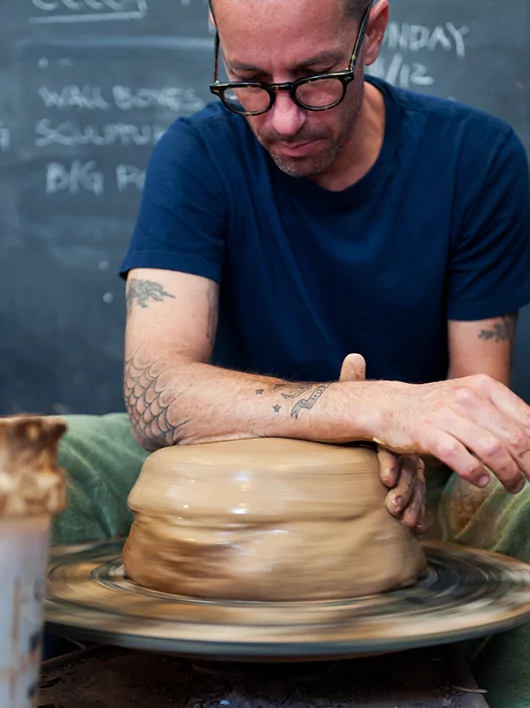
I was into pottery as a hobby before XL, and during XL. As I became more responsible for the business of the company, and less involved in the design, pottery became increasingly important to me, and eventually I left XL and became a potter full-time. The XL aesthetic per se, has very little influence on the aesthetic of the work I do now. The overarching theme that flows between architecture, clothing and pottery is making something for the human body.
4. GROWING UP YOU STUDIED ARCHITECTURE, ART AND DESIGN AT THE RHODE ISLAND SCHOOL OF DESIGN. I’M INTERESTED TO HEAR HOW ARCHITECTURE HAS INFLUENCED YOUR WORK, IF IT HAS AT ALL, AND IF THERE ARE ANY PARALLELS BETWEEN THE POTS YOU MAKE AND THE SHAPES/FORMS OF BUILDINGS.
There are no literal formal parallels, but my training in architecture was very thorough and deep, I loved it. My aesthetic is absolutely formed by the major architectural influences on me.
5. YOUR PIECES REMIND ME IN SOME WAYS OF ANCIENT RUINS, OR OF ANCIENTS BUILDS. FAMOUS ARCHITECTS I COULD RELATE THEM TO INCLUDE THE GREAT LOUIS KAHN AND ITALIAN DESIGNER CARLO SCARPA. ARE THERE ANY PARTICULAR ARTISTS, ARCHITECTS OR DESIGNERS THAT HAVE INSPIRED YOUR WORK?
Le Corbusier, Louis Kahn, Carlo Scarpa, Schindler, Tadao Ando. Modernists who were / are in love with their materials and handled them as masters. Forms rooted primarily in geometry. Abstract, but warm or expressive. Also artists like Frances Bacon, Miro, Hans Coper, Peter Voulkos, David Smith, Alexander Calder, Noguchi, Louise Nevelson, Morandi, Paul Klee, Picasso, Giacomett, Merce Cunningham …
6. WHAT’S YOUR PERCEPTION WHEN IT COMES TO MAKING POTS? SOME PEOPLE SEE IT AS PURELY FUNCTIONAL, OTHERS AS ART OR SCULPTURE, WHERE DO YOU STAND ON THIS?
I make pots that are mostly functional, but under the big umbrella of art. Clay is a ghettoized material, that people like to dismiss as craft. I like the flexibility of it in terms of being able to operate in the worlds of craft, art and design, that it has no inherent form to begin with, and then I can move it in any direction. I like to think of art, design and craft as three circles that each overlap a bit with the hot spot being where all three overlap, which is the smallest area … that’s where I try to operate, to the extent that I try to operate anywhere. Also, in some senses, the market kind of places you in the area that it wants you in, art, design or craft, and you can try to work within that market influence, or fight it, or ignore it. But it’s there as a force whether we like it or not.
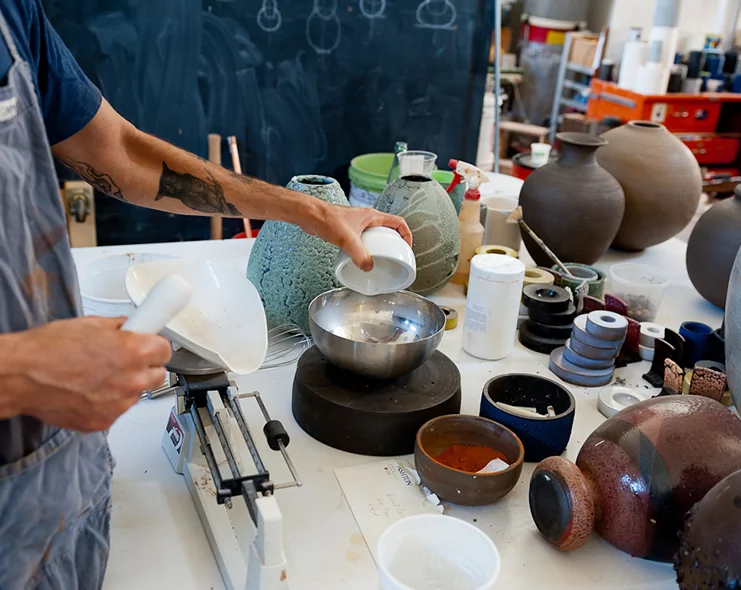
7. WHAT’S YOUR THINKING BEHIND THE TEXTURES AND COLOURS ON THE POTS YOU CREATE, WAS THERE A PARTICULAR ‘EUREKA’ MOMENT WHERE YOU EXPERIMENTED WITH THESE METHODS? OR WAS IT A SLOW PROCESS UP TO THIS POINT?
It has been a very slow and organic process of small discoveries that have built one upon the previous to get me where I am now. It has been following what feels right, and it continues to evolve in that same way.
8. YOU MUST USE A COMPLEXITY OF MATERIALS WHEN MAKING THESE BOLD LOOKING SHAPES, PARTICULARLY IN THE GLAZING. IN TERMS OF THE GLAZES HOW DO YOU FIND OUT WHAT WORKS, ALSO DO YOU FIRE IN DIFFERENT TEMPERATURES OR IS EACH PROJECT APPROACHED DIFFERENTLY?
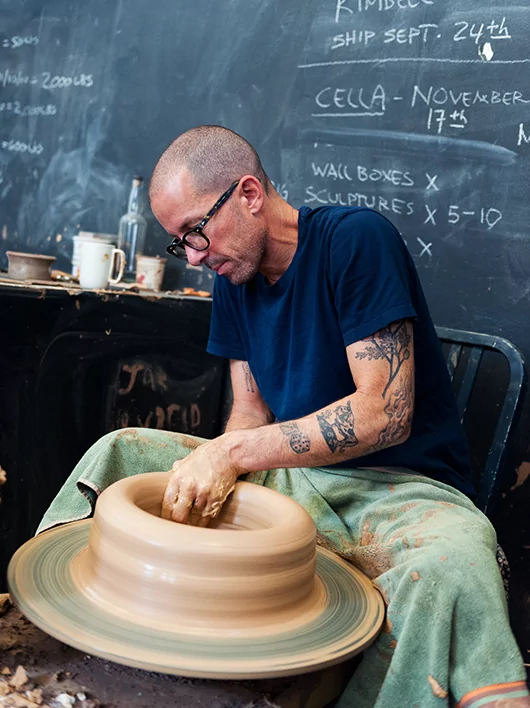
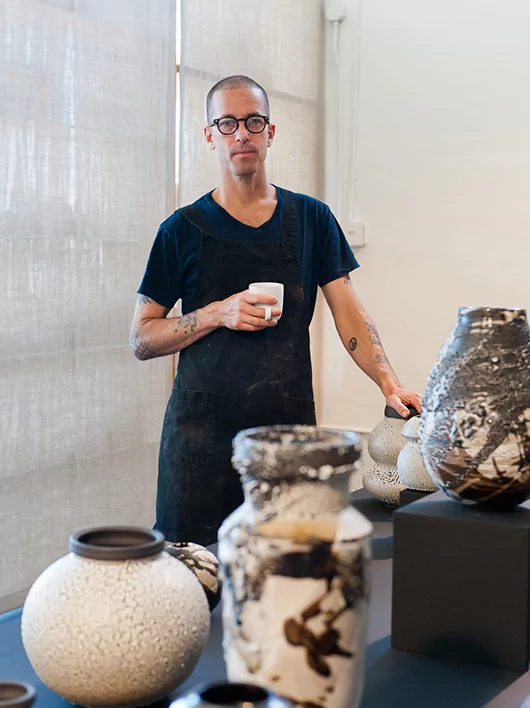
I have used mostly one clay body at one temperature in electric kilns for the last 15 years. However in the last year or two I have been exploring different clays and temperatures and firing techniques. Different projects are sometimes getting different materials and techniques. For example, I am working on a large show at the Laguna Art Museum in Laguna Beach, CA this October. There are four galleries that I will be using, and each will have very different types of work in and several different types of clay, glazes and firing techniques will be employed. There will be pots, sculptures, photographs and video. But it will all be very closely related and I hope form a unified show.
9. I PERSONALLY THINK ONE OF THE MAIN ATTRACTIONS TO YOUR WORK IS THE MYSTICISM AND SPONTANEITY, IS THIS INTENTIONAL OR DO YOU THINK IT JUST COMES ABOUT THROUGH THE EXPERIMENTAL PROCESS?
I like the idea of mystery, unknown or inexplicable things, not necessarily in a “mystical” or religious sense, just the great unknown and the power and curiosity of the unknown. I think that is one of the great things about art, how it can affect each person differently in a very personal way, and how much mystery exists in art.
10. IT SEEMS LIKE YOU ORIGINALLY STARTED OUT WITH QUITE A MINIMAL AESTHETIC, AND THEN MOVED ON TO WORK THAT AT TIMES CAN LOOK LIKE ROCK OR LAVA. IT’S AS THOUGH THE PIECES ARE CONNECTED TO NATURAL FORMS CREATED BY THE EARTH, WHICH I LOVE. WHAT MADE YOU STEP AWAY FROM THIS ORIGINAL AESTHETIC, DID YOU FEEL IT HAD TOO MANY BOUNDARIES?
I think that the forms that I use are still very “minimal” or elemental, or modern or based on nature in a geometry sense. A sphere or an egg, or a shape that may reference a torso, these are all forms that are very familiar to us. So I feel like I need those forms as a sort of canvas to then explore the surface treatment so aggressively. If the forms weren’t so strong, I don’t think the surfaces could be so intense … the overall piece wouldn’t work as well.
11. TO ME YOU APPEAR TO BE A CREATIVE WHO’S ALWAYS ADAPTING AND LEARNING AS YOU GO ALONG, EXPERIMENTATION IS IN YOUR NATURE. WHERE DO YOU THINK THIS CAME FROM AND ARE THERE ANY PARTICULAR THEMES THAT YOU’RE TOYING WITH AT THE MOMENT?
I don’t know where it comes from. I like learning, seeing things and making things. It’s like being a sponge. Soak a bunch of water and dirt in, let it sit, squeeze it and see what comes out.
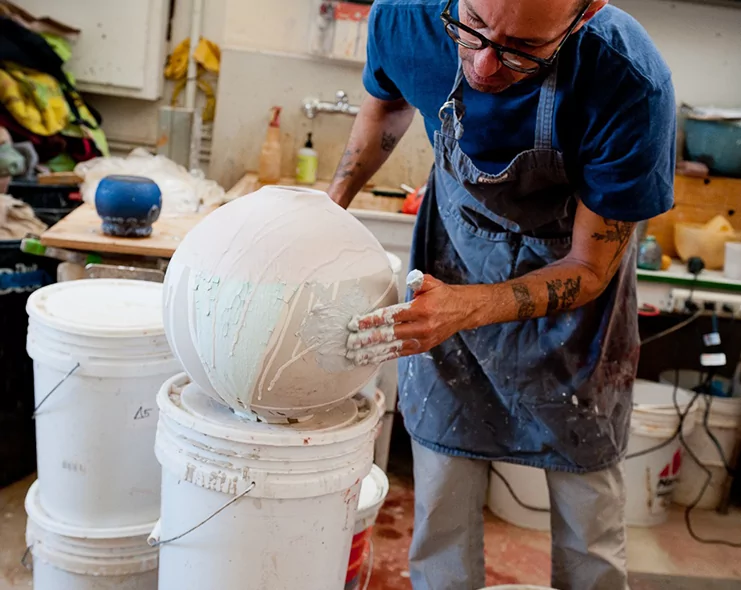
12. LOOKING BACK WHEN YOU TRAVELLED TO JAPAN IN 2005, LATER RETURNING IN 2006, WHAT WOULD YOU SAY YOU GAINED FROM THE TRIP ITSELF? CAN YOU POINT OUT ONE PARTICULAR MOMENT THAT WAS INSPIRING?
There were many inspiring things about those trips. First was visiting Mashiko, a traditional pottery and farming town. It had 300 family kilns in operation at the time I first visited (much has changed since the earthquake and nuclear disaster in 2011). I met, through a mutual friend in Tokyo, the Sekizawa family, who were three men, and became very close with them. I wound up working at their pottery for about a month in 2006. They are a very inspiring family in terms of how they live, humbly and elegantly. Being there, in Mashiko and with the Sekizawas, had a big influence on me.
13. YOU MET THE HAMADA FAMILY OUT IN JAPAN ON YOUR VISIT, WITH SHOJI HAMADA BEING QUITE AN ICON IN THE POTTERY WORLD, WHAT DID YOU PICK UP FROM THIS EXPERIENCE? I’M GUESSING IT MUST OF BEEN QUITE OVERWHELMING?
It was a weird and fun and kind of formal day. They were very gracious towards me. But there was no deep connection to them like there was for me to the Sekizawas. Hamada is important as an icon and a figure head, bridge builder, etc. Less so as a potter in my mind. But for sure it was a day that I will remember for the rest of my life.
14. JUST FLICKING THROUGH THE PHOTOGRAPHS IN JAPAN, THE WAY OF LIFE LOOKS TOTALLY DIFFERENT AND VERY CALM COMPARED TO WHAT US WESTERNERS EXPERIENCE. DID YOU TAKE ANY OF THESE ELEMENTS FROM THE FAR EAST IN TO YOUR OWN LIFESTYLE?
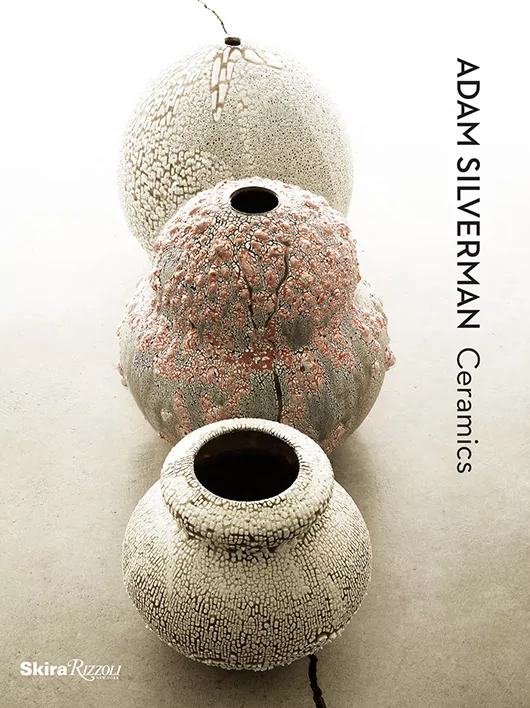
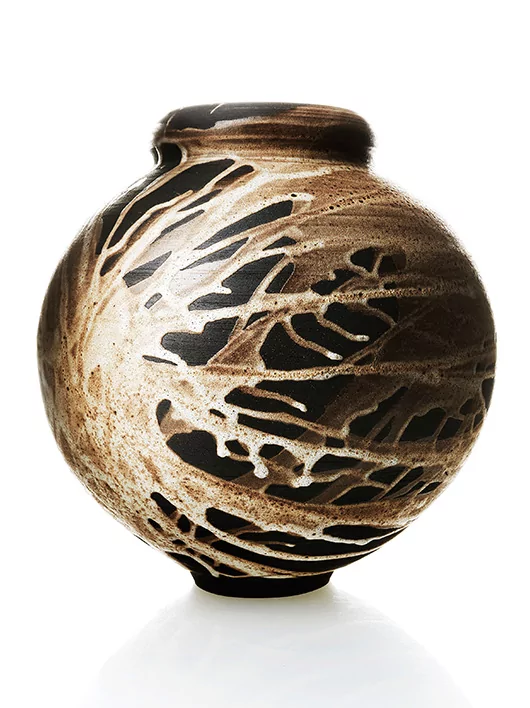
It couldn’t be more different in Mashiko, than my life in LA. Polar opposites. And I love it there and visit as often as possible … but in the end, I am a coffee drinking, minivan driving, father of four kids, American, Los Angeles potter, who works in the middle of the big dirty city. I like my life a lot, but it is good to escape from time to time. And get a literal and metaphorical breath of fresh air.
15. AS A PARTNER AND STUDIO DIRECTOR OF HEATH CERAMICS I CAN IMAGINE YOU HAVE TO WEAR QUITE A FEW HATS, SO TO SPEAK. HOW DO YOU JUGGLE ALL THESE DIFFERENT SITUATIONS AND ROLES?
It is pretty natural and easy to do. We have a great team of people at Heath, so I can mostly work in the studio and on big company wide issues with Cathy and Robin … the nitty gritty of the stores, manufacturing etc. are handled by people whose jobs those things are.
16. IT SEEMS LIKE YOU’RE GETTING ASKED TO WORK ON MORE AND MORE EXHIBITIONS ALL OVER THE WORLD, WHAT ARE THE CHALLENGES WHEN STARTING A NEW EXHIBITION. HOW DO YOU APPROACH THEM, COULD YOU SUMMARISE SOME OF YOUR KEY THOUGHTS?
Each opportunity comes with it’s own context and set of issues, which usually start the ball rolling in terms of my responses. The Laguna Museum is on a cliff above the Pacific Ocean, which is a very specific and strong context. It is also a place that has a strong craft and art history and context. Then there is the museum itself, which provided four galleries to work with. So those three sets of conditions got me started toward where the project will end up. Sometimes I am working on an idea and need a place to present it, and sometimes the place informs the work completely, like the Kimbell project. Mostly it is a combination of the two.
17. LASTLY, WHAT IDEAS HAVE YOU GOT UP YOUR SLEEVE? ANY PROJECTS YOU CAN SHED LIGHT ON, WHAT SHOULD WE EXPECT TO SEE IN THE FUTURE FROM ADAM SILVERMAN AS DESIGNER AND CREATIVE?
Fall 2013 is going to be a very busy time. I have a Rizzoli monograph (purchase here) coming out September 24th. Then I will have shows and book events at Heath in LA and SF the last weekend in September. The Laguna show opens in October, and I’ll be showing with Edward Cella at Texas Contemporary in October, and a book party in Marfa and New York. Then two shows in Tokyo in November, one at Play Mountain and one at Tomio Koyama, then in December I’ll be holding a book event and installation at Chariots of Fire in Venice, CA. In January I will sleep for the month.
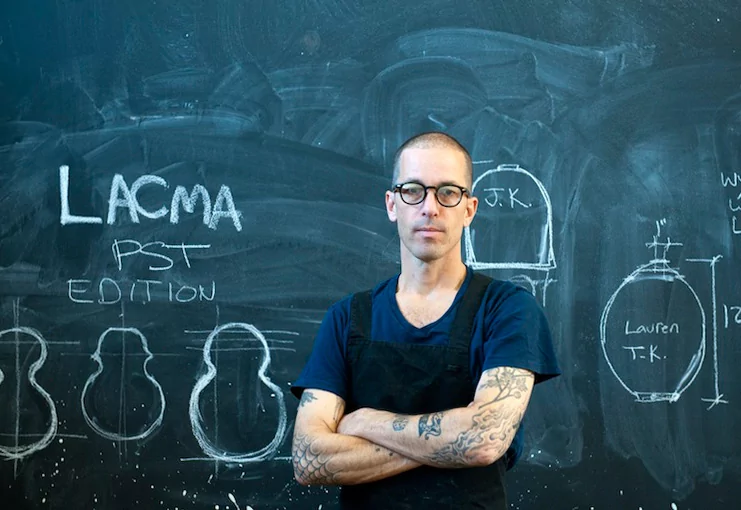




Post a comment